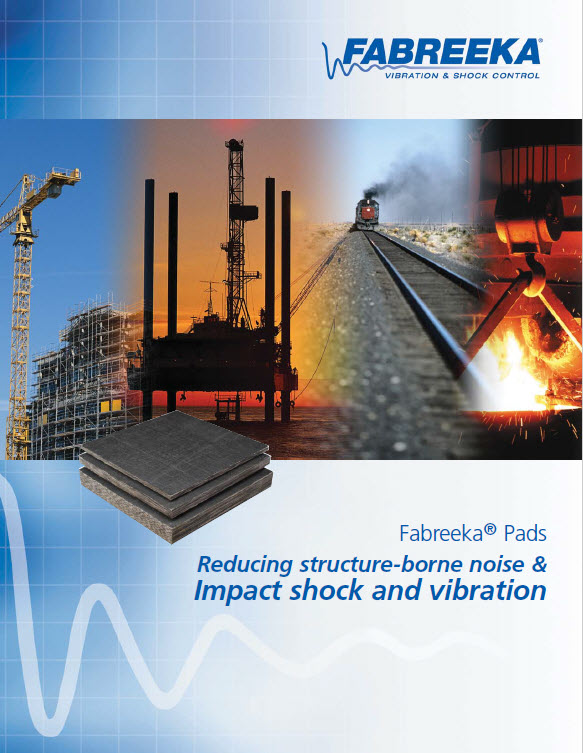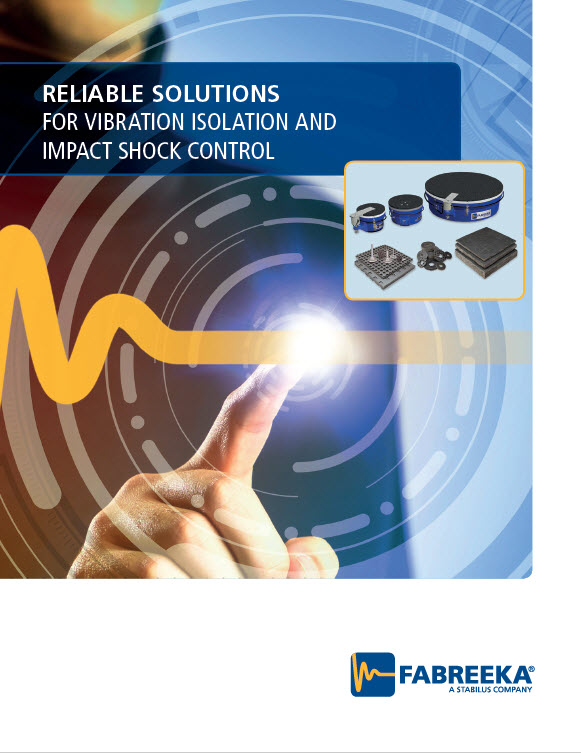



Fabreeka pad is the original preformed fabric reinforced, elastomeric pad developed in 1936. The properties of the Fabreeka cotton duck pad are exceptionally suited for impact shock control, vibration isolation and structure-borne noise insulation. Fabreeka pad can be used as a bearing pad as well as for isolation washers, bushings and OEM parts.
Fabreeka pad has been used for over 80 years for mounting heavy machinery where absorption of impact shock is required. Meeting or exceeding MIL-C-882 and MIL-E-5272 specifications, Fabreeka pad prevents cracking and flaking of concrete, eliminates the need for grout and prolongs the life of both machines and structures. Each preformed fabric pad made by Fabreeka is scientifically constructed to give years of service under the most severe operating conditions.
When considering vibration isolation, usually more than one disturbing frequency is present in a machine. As a general rule, an attempt should be made to isolate the frequency producing the largest vibration amplitude, while avoiding resonance with the other disturbing frequencies. Fabreeka’s fabric reinforced elastomeric material, with its resilience, minimal deflection and high strength, often serves as a more practical vibration isolator than softer materials.
Very effective, flexible and tough
Fabreeka’s part in isolating noise is one of reducing structure-borne noise. Fabreeka reduces mechanical vibrations which can be converted to air-borne noise. When isolating structure-borne noise, it is essential that all conductive paths of vibration be blocked. Therefore, Fabreeka pads, washers and bushings are required to completely break the metal-to-metal contact between the isolated unit and its support.
Fabreeka bearing pads were first used as a bridge bearing and are commonly used as a structural bearing element accommodating surface irregularity and rotations between load bearing faces. The preformed fabric pads can also be provided with a Teflon® surface for use in expansion bearings and pipe slides.
Depending upon the size and thickness, Fabreeka pad can ultimately withstand loads up to 10,000 psi. Normally, compressive stresses are designed not to exceed 2,000 psi to extend service life and reduce permanent set



What are the vibration isolation characteristics of Fabreeka pad?
Please refer to pages 8-15 in our Fabreeka Pad brochure.
Does all “cotton duck” reinforced pad material meet the MIL-C-882 specification?
No. The MIL-C-882 specification requires specific strength, deflection, density and permanent set properties.
How can I be sure the material I am buying meets the MIL-C-882 specification?
The supplier should supply a material certification stating that the material meets MIL-C-882. In addition, the deflection, creep and environmental test data should be provided or certified to.
What environmental tests are involved with the MIL-C-882 specification?
The pad material must pass several environmental tests per MIL-E-5272A.
What is creep?
Creep is the deformation of rubber is influenced by the length of time under stress. If the rubber is statically loaded to a given amount, as occurs for example by the support of a machine, then an elastic deformation takes place superseded after a longer period of time by creep. Creep behavior follows an exponential law and is concluded sometime afterward. If the isolator is released, then its shape returns elastically. High elastic grades show a small residual strain and minimal creep. With good elastic qualities, the creep lies between 5% and 10% of the total elastic strain.
What is permanent set?
Permanent set, or residual strain, takes place after prolonged loading and unloading of an isolator, and lies between 2% and 5% of its original thickness.
How is damping different than isolation/absorption?
The essential properties of an isolator are natural frequency (developed by the spring rate or stiffness) and an energy dissipating mechanism known as damping. In some types of isolators, the stiffness or natural frequency and damping properties are contained in a single element such as elastomers, cork, rubber mats, etc. Other types of isolators may have separate means of providing stiffness and damping as is the case with air springs (pneumatic isolators) and coil steel springs, which are relatively undamped until used in conjunction with auxiliary damping elements such as orifice flow restrictors and viscous dampers. The purpose of damping in an isolator is to reduce or dissipate energy as rapidly as possible. Damping is also beneficial in reducing vibration amplitudes at resonance. Resonance occurs when the natural frequency of the isolator coincides with the frequency of the source vibration.
The ideal isolator would have as little damping as possible in its isolation region as much as possible at the isolator’s natural frequency to reduce amplification at resonance. Damping, however, can also lead to a loss of isolation efficiency.
Can Fabreeka pad material act as an electrical insulator?
Fabreeka pad has a dielectric strength of 12,500 volts (210 volts/mil) and a resistivity of 8.5 x 10e9 ohm-cm. (Insulating material classification requires a resistivity greater than 10e5 ohm-cm.) As a comparison, natural rubber has a resistivity value of 10e15 ohm-cm. Fabreeka pad has a dielectric constant of 9.34, with a power factor of 0.201 and a loss index of 1.881. All of these values are for Fabreeka pad at a standard room conditions of 73°F (213°C) and 50% relative humidity.
How does static spring rate differ from dynamic spring rate?
The static deflection principle can only be used to determine the natural frequency of an isolator if the isolator under consideration is both linear and elastic. For example: rubber, felt, fiberglass and composite materials tend to be non-linear and exhibit a dynamic spring rate that differs from the static spring rate.
Similarly, the spring rate of a pneumatic isolator changes when undergoing a change from the static condition to a dynamic condition.
The natural frequency as calculated based on static load vs. deflection data will give inaccurate lower natural frequencies as compared to realistic experience during dynamic vibration.
Any isolator with a calculated natural frequency based on static deflection may not behave in the predicted way because the dynamic spring rate differs from the static spring rate. It is the dynamic natural frequency that has to be used in isolation calculations rather than the static natural frequency.
What are the thermal properties of Fabreeka material?
Thermal conductivity of Fabreeka material is expressed in power per unit of area divided by temperature gradient in degrees per unit of length. The Imperial units are 1.90 BTU INCH/HR/FT-SQ/Degrees F.
What are the manufacturing tolerances of the Fabreeka Pad?
Manufacturing tolerances vary by thickness and part geometry. Please contact Fabreeka’s Engineering department at 1-800-322-7352 or info@fabreeka.com to discuss the tolerances for your application.